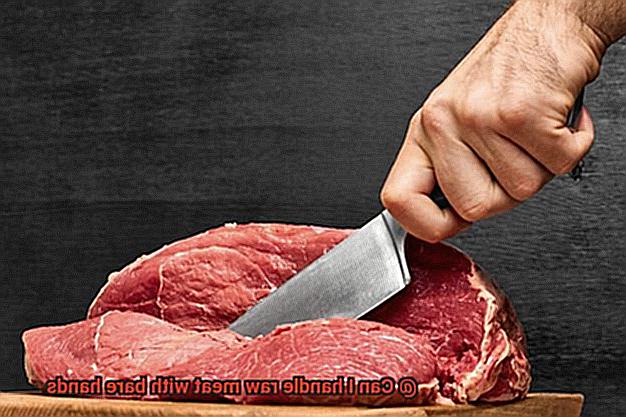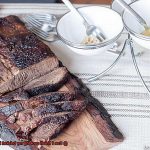Are you a meat lover who enjoys cooking up delicious dishes in the kitchen? If so, then you know that handling raw meat is an essential part of the process. From seasoning to marinating, your hands are the primary tools used in preparing meat-based meals. But have you ever pondered whether it’s safe to handle raw meat with bare hands? Can I handle raw meat with bare hands? Well, the answer isn’t as simple as a yes or no.
When it comes to handling raw meat, there are several factors to consider before taking the plunge. Raw meat is teeming with bacteria and germs that can lead to severe illness if not handled correctly. Contaminated meat can cause food poisoning, which could result in hospitalization or even death.
However, don’t despair. Proper hygiene practices and preparation techniques can help mitigate these risks and allow you to handle raw meat safely. From washing your hands diligently and sanitizing surfaces to using gloves, there are several ways you can ensure that your hands and kitchen remain clean and hygienic.
So, let’s explore the intriguing question – Can I handle raw meat with bare hands? In this blog post, we’ll delve into the risks and benefits of handling raw meat without gloves or other protective gear. We’ll offer expert tips on how to prevent contamination while ensuring that your dishes taste great and are safe for consumption. So buckle up and join us on this educational journey.
Contents
Types of Meat and Bacterial Contamination
When it comes to handling raw meat with bare hands, the type of meat is a crucial factor that can determine the level of bacterial contamination and associated risks. Let’s delve into the different types of meat and their specific bacterial risks.
Poultry
Chicken and turkey are notorious for carrying harmful bacteria such as Salmonella and Campylobacter. These bacteria thrive in the intestines of poultry and can cause serious food poisoning if ingested by humans. Therefore, it’s best to handle poultry with care and avoid touching it with your bare hands. Always use gloves or wash your hands thoroughly before and after handling it, and cook it to the appropriate temperature to kill any bacteria present.
Beef and Pork
While beef and pork have lower levels of bacterial contamination compared to poultry, they can still carry harmful bacteria such as E.coli and Listeria. These bacteria can cause severe illnesses or even death if not handled properly. It’s important to handle beef and pork with care, use separate cutting boards for raw and cooked meats, and cook them to the appropriate temperature using a meat thermometer.
Seafood
Seafood can also harbor harmful bacteria like Vibrio and Norovirus. Moreover, some types of fish may contain toxins like mercury that can cause health problems if consumed in large quantities. Therefore, it’s crucial to handle seafood with care, avoid cross-contamination with other foods, and follow proper food safety practices such as cooking to the appropriate temperature.
Ground Meat
Ground meat has a higher risk of bacterial contamination compared to whole cuts of meat because it has more surface area that comes into contact with other surfaces during processing. Therefore, it’s important to handle ground meat with care, avoid touching it with your bare hands, and cook it thoroughly to kill any bacteria present.
In conclusion, understanding the types of meat and their associated risks for bacterial contamination is crucial for safe food handling practices. Always wash your hands thoroughly before and after handling raw meat, use gloves or separate utensils to avoid cross-contamination, and cook the meat to the appropriate temperature using a meat thermometer.
Cooking Method and Risk of Foodborne Illness
Cooking meat to the correct temperature is crucial in preventing foodborne illnesses. However, the manner in which we cook our meat can also impact the risk of contamination. Grilling, in particular, can be a high-risk method if proper precautions are not taken. The heat from the grill may not evenly penetrate the meat, leaving certain parts undercooked and potentially contaminated.
To reduce the risk of contamination when preparing meat dishes, it’s important to follow proper handling techniques. Avoid using bare hands as much as possible since bacteria present on hands can easily transfer onto the meat. Instead, use gloves or utensils to handle raw meat. In cases where hands are used, ensure thorough washing before and after handling the meat.
Cross-contamination is another critical factor to consider. This occurs when bacteria from raw meat comes into contact with other foods, utensils, or surfaces in the kitchen. To prevent cross-contamination, keep raw meat separate from ready-to-eat foods and use separate cutting boards and utensils for each type of food.
When grilling meat dishes, use a meat thermometer to ensure that the internal temperature of the meat reaches a safe temperature. Beef should be cooked to an internal temperature of 145°F while poultry should reach an internal temperature of 165°F. By doing this, any harmful bacteria present in the meat will be killed off.
It’s also essential to be aware of the symptoms of foodborne illness, such as nausea, vomiting, diarrhea, fever, and abdominal pain. If you suspect that you may have contracted a foodborne illness, seek medical attention immediately.
Personal Hygiene Practices
By following some essential personal hygiene practices, you can ensure that you are preparing food safely and protecting yourself and others from harmful bacteria.
Firstly, always wash your hands thoroughly with soap and warm water before and after handling raw meat. Bacteria can easily transfer from the meat to your hands and from your hands to other surfaces, utensils, and even other food items. It is also important to keep your nails clean and trimmed since bacteria can accumulate under them.
If you choose to handle raw meat with bare hands, make sure you wash your hands frequently throughout the process and avoid touching your face, hair, or any other part of your body. To provide an additional barrier between the meat and your skin, it is recommended to wear gloves when handling raw meat.
Disinfecting any surfaces or utensils that come in contact with raw meat is also crucial. Ensure that cutting boards, knives, and countertops are cleaned thoroughly with hot soapy water before being disinfected with a solution of one tablespoon of bleach per gallon of water. This helps to kill any bacteria that may have come into contact with these surfaces or utensils.
The Benefits of Wearing Gloves or Utensils when Handling Raw Meat
Firstly, it is important to note that raw meat can contain harmful bacteria such as Salmonella and E. coli that can cause foodborne illnesses. By wearing gloves or using utensils, you can prevent these bacteria from coming into contact with your skin and potentially spreading to other surfaces or foods. This simple precaution significantly reduces the risk of contamination and helps keep you and your loved ones safe.
Another benefit of wearing gloves or using utensils is that it can help protect your hands from cuts and injuries while working with sharp knives and other kitchen tools. Accidental injuries can be debilitating and put you out of commission for days on end. By taking this simple precaution, you can minimize the risk of injury and keep your hands safe while you work.
To delve deeper into the benefits of wearing gloves or using utensils, let’s explore some sub-topics:
Reducing the Risk of Contamination:
Wearing gloves or using utensils when handling raw meat can significantly reduce the risk of contamination. Preventing harmful bacteria from coming into contact with your skin and other surfaces can help protect yourself and others from getting sick.
Keeping Your Hands Safe:
Handling sharp knives and other kitchen tools can be dangerous, especially when working with raw meat. Wearing gloves or using utensils is a great way to prevent cuts and other injuries, keeping your hands safe while you work.
Maintaining Proper Hygiene:

Wearing gloves or using utensils is also an excellent way to maintain proper hygiene in the kitchen. By keeping your hands clean and free of bacteria, you can help prevent the spread of illness-causing germs and keep your food safe to eat.
Cross-Contamination and How to Avoid It
Cross-contamination is a serious issue in the food industry that can lead to harmful bacteria spreading through direct or indirect contact. One of the most significant risks is handling raw meat with bare hands, which can cause foodborne illnesses such as salmonella, E.coli, and Campylobacter. However, there are several practical tips to avoid cross-contamination and keep your kitchen clean and your meals safe.
Good hygiene practices are essential in preventing cross-contamination. Wash your hands thoroughly with soap and warm water before and after handling raw meat. Use separate cutting boards and utensils for raw meat and other foods, and ensure that raw meat is refrigerated and kept away from ready-to-eat foods.
Properly cooking meat is also crucial in eliminating any harmful bacteria that may be present. The USDA recommends cooking beef, pork, lamb, and veal to an internal temperature of 145°F with a three-minute rest time before carving or consuming. Ground meats should be cooked to an internal temperature of 160°F, while poultry should be cooked to an internal temperature of 165°F.
An additional precaution you can take is using disposable gloves when handling raw meat. While gloves can reduce the risk of cross-contamination even further, they are not a substitute for proper handwashing and should be changed frequently during food preparation.
To summarize, these simple steps can significantly reduce the risk of cross-contamination when handling raw meat:
- Wash your hands thoroughly before and after handling raw meat
- Use separate cutting boards and utensils for raw meat and other foods
- Keep raw meat refrigerated and away from ready-to-eat foods
- Cook meat to the appropriate internal temperature
- Consider using disposable gloves as an extra precaution
The Risks of Not Wearing Gloves or Utensils when Handling Raw Meat
Raw meat can contain harmful bacteria such as E. coli, Salmonella, and Campylobacter that can cause foodborne illnesses if ingested. These bacteria can easily spread from the meat onto your hands, clothing, and surfaces, leading to cross-contamination.
Cross-contamination occurs when bacteria from raw meat come into contact with other foods, utensils, or surfaces. This is a serious issue that can result in severe illnesses like diarrhea, vomiting, and fever. Therefore, it is crucial to take necessary precautions while handling raw meat.
Here are some of the significant risks you face if you don’t wear gloves or use utensils:
- Increased Risk of Cuts and Burns: Handling raw meat with bare hands increases the risk of cuts and burns. The sharp edges of knives used to cut raw meat can cause cuts on the fingers, which can become infected with bacteria from the meat. Additionally, hot grease or oil used to cook the meat can splash onto bare skin causing painful burns.
- Spread of Harmful Bacteria: Not wearing gloves or using utensils when handling raw meat increases the risk of spreading harmful bacteria. It’s crucial to use separate cutting boards and utensils when preparing different types of food to avoid cross-contamination.
- Foodborne Illnesses: Raw meat contains harmful bacteria that can cause foodborne illnesses. These illnesses can lead to severe health issues and even death if left untreated.
To reduce these risks, it is recommended to always wear gloves or use utensils when handling raw meat. Disposable gloves should be changed frequently, especially when handling different types of meat. Utensils should also be washed thoroughly with soap and hot water after each use.
Food Safety Guidelines for Handling Raw Meat
Whether you’re a seasoned chef or a beginner in the kitchen, it’s crucial to follow these guidelines to prevent cross-contamination and ensure that the food you prepare is safe to eat.
First and foremost, never handle raw meat with bare hands. Raw meat can contain harmful bacteria such as Salmonella, E. coli, and Campylobacter, which can cause serious foodborne illnesses. To prevent the spread of these bacteria, it’s recommended that you use gloves or utensils when handling raw meat.
If you must handle raw meat with bare hands, remember to wash your hands thoroughly before and after handling the meat. This will help to prevent the spread of bacteria from your hands to other surfaces or foods.
Another important guideline is to keep raw meat separate from other foods. Cross-contamination occurs when harmful bacteria from raw meat come into contact with other foods, utensils, or surfaces. Therefore, it’s important to store raw meat in a separate container or on a separate shelf in the refrigerator, and use separate cutting boards and utensils when preparing it.
When cooking raw meat, ensure that it’s cooked to the appropriate temperature to kill any harmful bacteria present. The USDA recommends cooking ground beef to an internal temperature of 160°F and poultry to an internal temperature of 165°F. Using a food thermometer can help you determine if your meat has reached the proper temperature.
In addition to these guidelines, it’s important to clean and sanitize all surfaces and utensils that come into contact with raw meat. This includes cutting boards, knives, countertops, and sinks. Use hot soapy water and a sanitizing solution (such as a mixture of water and bleach) to clean these items thoroughly.
To summarize, here are the key food safety guidelines for handling raw meat:
- Use gloves or utensils when handling raw meat.
- Wash your hands thoroughly before and after handling raw meat.
- Keep raw meat separate from other foods to prevent cross-contamination.
- Cook raw meat to the appropriate temperature to kill harmful bacteria.
- Clean and sanitize all surfaces and utensils that come into contact with raw meat.
nGRktg6teMc” >
Conclusion
In conclusion, handling raw meat with bare hands is a risky business. Raw meat is a breeding ground for harmful bacteria and germs that can cause severe food poisoning if not handled correctly. However, don’t let this scare you away from cooking your favorite meals. With proper hygiene practices and preparation techniques, you can handle raw meat safely.
It’s crucial to understand the different types of meat and their specific bacterial risks when handling raw meat. Poultry, beef, pork, seafood, and ground meat all have varying levels of contamination that require different handling techniques. So it’s essential to know what you’re dealing with before diving in.
Cooking method also plays a critical role in preventing foodborne illnesses. Proper cooking temperatures must be reached to kill any harmful bacteria present in the meat. Grilling can be a high-risk method if proper precautions are not taken.
Personal hygiene practices like washing hands frequently with soap and warm water before and after handling raw meat, using gloves or utensils for handling raw meat, disinfecting surfaces or utensils that come into contact with raw meat are also important in preventing cross-contamination.
By following these guidelines for food safety when handling raw meat, you can reduce the risk of harmful bacteria spreading through direct or indirect contact.






